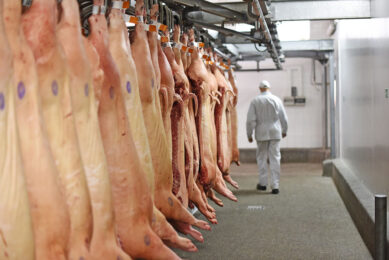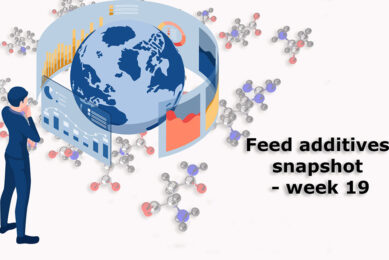Commodity speculators: Blame them or embrace them?

The role of speculators in commodity futures markets has come under increased scrutiny this year, especially as food prices kept a historic pace alongside a financial meltdown and the US presidential election. Feed Tech asks experts about the positions of speculators and investment banks in the futures trade and how governments should – or should not – handle them.
Since trade rules made it more appealing for investment banks to enter the
commodities field,more and more financial players have been supplementing their
stock portfolios with plays in physical markets – wheat, corn and soybeans – as
well as gold and oil. Flooding the market with billions, Wall Street firms have made it much easier for
billions, Wall Street firms have made it much easier for
the ordinary investor to buy and sell grain and other commodities by offering
futures-based indexes for sale. This has not been a welcome trend however, for
many commercial interests in the feed and farm world. In a conversation about
hedging, one farm management firm in Kansas even tells Feed Tech, “Prices just
don’t follow the rules of supply and demand as closely as they used to because
of the amount of speculation in the market…so traditional thinking is kind of
thrown out the window.”
commodities field,more and more financial players have been supplementing their
stock portfolios with plays in physical markets – wheat, corn and soybeans – as
well as gold and oil. Flooding the market with
the ordinary investor to buy and sell grain and other commodities by offering
futures-based indexes for sale. This has not been a welcome trend however, for
many commercial interests in the feed and farm world. In a conversation about
hedging, one farm management firm in Kansas even tells Feed Tech, “Prices just
don’t follow the rules of supply and demand as closely as they used to because
of the amount of speculation in the market…so traditional thinking is kind of
thrown out the window.”
This statement reflects a larger perception in the feed and farm sectors
that speculative investment positions have created a bubble where market prices
far exceed fundamental values of supply and demand. Because index fund
speculation gambles on the premise that values will always rise over the
long-term, it is accused of artificially inflating prices. This perceived force
on the market has spawned proposals in the US Congress to officially curb
speculation practices.
that speculative investment positions have created a bubble where market prices
far exceed fundamental values of supply and demand. Because index fund
speculation gambles on the premise that values will always rise over the
long-term, it is accused of artificially inflating prices. This perceived force
on the market has spawned proposals in the US Congress to officially curb
speculation practices.
For evidence of the vilification of speculators in the press and politics
consider this passage from a campaign speech made this summer. “We must purge
the market of the reckless speculation, unrelated to any kind of productive
commerce that has inflated the price of gasoline— at the expense of working men
and women across our country. With new regulations, I intend to assure integrity
in oil-futures trading, and to protect the publics’ interest,” said Sen. John
McCain (R-AZ). Crude oil and gasoline are often featured in “baskets” or index
funds offered by Wall Street firms that also include wheat, feeder cattle, corn
and other agriculture and feed related products. These indexes, sold by
companies like Goldman Sachs, Pimco and others, have created a grand influx of
money into the market that seems to make people nervous.
consider this passage from a campaign speech made this summer. “We must purge
the market of the reckless speculation, unrelated to any kind of productive
commerce that has inflated the price of gasoline— at the expense of working men
and women across our country. With new regulations, I intend to assure integrity
in oil-futures trading, and to protect the publics’ interest,” said Sen. John
McCain (R-AZ). Crude oil and gasoline are often featured in “baskets” or index
funds offered by Wall Street firms that also include wheat, feeder cattle, corn
and other agriculture and feed related products. These indexes, sold by
companies like Goldman Sachs, Pimco and others, have created a grand influx of
money into the market that seems to make people nervous.
“There’s new species that has large amounts of money and sticks to the
long side of the market,” says Scott Irwin, professor of agricultural economics
at the University of Illinois (UI), in Urbana, Ill. “One of the primary concerns
expressed by the industry is the magnitude of the commodity index activity.
Presumably, the sheer size of the index fund positions may allow them to distort
prices or price relationships across markets.”
long side of the market,” says Scott Irwin, professor of agricultural economics
at the University of Illinois (UI), in Urbana, Ill. “One of the primary concerns
expressed by the industry is the magnitude of the commodity index activity.
Presumably, the sheer size of the index fund positions may allow them to distort
prices or price relationships across markets.”
Contrary research
Since late last year, the controversy
surrounding commodities speculation has led to a surge in research and debate on
the influence of this activity on markets. Notably, “The Adequacy of Speculation
in Agricultural Futures Markets: Too Much of a Good Thing,” was released in June
and authored by Scott Irwin, Dwight Sanders at the University of Southern
Illinois
and Robert Merrin at the University of Maastricht, Netherlands.
Since late last year, the controversy
surrounding commodities speculation has led to a surge in research and debate on
the influence of this activity on markets. Notably, “The Adequacy of Speculation
in Agricultural Futures Markets: Too Much of a Good Thing,” was released in June
and authored by Scott Irwin, Dwight Sanders at the University of Southern
Illinois
and Robert Merrin at the University of Maastricht, Netherlands.
This study, which was sponsored by UI, says that speculators ultimately
have not forced prices away from the fundamental values and that prices are
still tracking ordinary patterns. The caustic world resource crisis, however,
has led to unqualified accusations and analyses often based on politics rather
than careful research and calculation. “Once politicians start talking about
[markets and finance] you can be sure that they’re getting it wrong,” says Ernie
Goss, professor of economics at Creighton University (CU).
have not forced prices away from the fundamental values and that prices are
still tracking ordinary patterns. The caustic world resource crisis, however,
has led to unqualified accusations and analyses often based on politics rather
than careful research and calculation. “Once politicians start talking about
[markets and finance] you can be sure that they’re getting it wrong,” says Ernie
Goss, professor of economics at Creighton University (CU).
Based in Omaha, Neb., a financial centre of the Midwest, CU conducts a
monthly survey of rural banks in several states and publishes their findings
each month to forecast the growth of the agricultural sector in the Midwest.
“More people are becoming bearish on commodities because of a global economic
cool-down,” Goss tells Feed Tech. Speculators have been accused by politicians,
energy companies, and feed traders of distorting markets because they have no
physical stake in the supply chain. Because their involvement does not involve
actual commerce, their place in the market is pegged as artificial and damaging.
The experts say, however, regulating or removing the speculators activities
would cause the real harm.
monthly survey of rural banks in several states and publishes their findings
each month to forecast the growth of the agricultural sector in the Midwest.
“More people are becoming bearish on commodities because of a global economic
cool-down,” Goss tells Feed Tech. Speculators have been accused by politicians,
energy companies, and feed traders of distorting markets because they have no
physical stake in the supply chain. Because their involvement does not involve
actual commerce, their place in the market is pegged as artificial and damaging.
The experts say, however, regulating or removing the speculators activities
would cause the real harm.
Speculator facilitates
Corroborating findings from
the University of Illinois, Fred Seamon, analyst for the Chicago Mercantile
Exchange (CME) Group, says that speculators certainly facilitate deals between
producers and processors. “If a farmer knows he can make money at a certain
price he sells that price to the speculator,” Seamon says. “Then the speculator
will in turn sell it off to an
ethanol producer [or another processing
interest] at a price they’re also comfortable with…so the speculator certainly
is a facilitator of deals.”
Corroborating findings from
the University of Illinois, Fred Seamon, analyst for the Chicago Mercantile
Exchange (CME) Group, says that speculators certainly facilitate deals between
producers and processors. “If a farmer knows he can make money at a certain
price he sells that price to the speculator,” Seamon says. “Then the speculator
will in turn sell it off to an
ethanol producer [or another processing
interest] at a price they’re also comfortable with…so the speculator certainly
is a facilitator of deals.”
Speculators can actually help to soften blows in periods of economic
downturns because they assume risks that the farmers and processors wish to
avoid. For that reason, CME maintains that the government should be very careful
in regulating speculation. “Even if every economist and every member of Congress
had genuine evidence that excess speculation was distorting prices, it would be
a monumental mistake to try to cure that problem by mandating an arbitrary
increase in performance bond, commonly called margin, above prudent levels,”
said Terrence Duffy Chairman of CME Group in testimony before the US House of
Representatives in July.
downturns because they assume risks that the farmers and processors wish to
avoid. For that reason, CME maintains that the government should be very careful
in regulating speculation. “Even if every economist and every member of Congress
had genuine evidence that excess speculation was distorting prices, it would be
a monumental mistake to try to cure that problem by mandating an arbitrary
increase in performance bond, commonly called margin, above prudent levels,”
said Terrence Duffy Chairman of CME Group in testimony before the US House of
Representatives in July.
Facts and figures
The average position size of the
index trader can be over ten-times the size of positions held by interests in
different trading categories, and the average number of banks participating in
the agricultural commodity markets ranges from five in feeder cattle to 14 in
wheat. Consistent position by commercial banks in the livestock futures markets
began in mid-to-late 2005, and since that time hoards of more futures contracts
have been exchanged in US trade scenarios.
The average position size of the
index trader can be over ten-times the size of positions held by interests in
different trading categories, and the average number of banks participating in
the agricultural commodity markets ranges from five in feeder cattle to 14 in
wheat. Consistent position by commercial banks in the livestock futures markets
began in mid-to-late 2005, and since that time hoards of more futures contracts
have been exchanged in US trade scenarios.
Wall Street has learned that building a portfolio containing stocks as
well as commodity futures promotes risk diversity. “The stock market and futures
markets aren’t connected – or at least they’re uncorrelated,” Irwin says. “So
investing in commodity futures reduces the risk of a stock and bond
portfolio.”
well as commodity futures promotes risk diversity. “The stock market and futures
markets aren’t connected – or at least they’re uncorrelated,” Irwin says. “So
investing in commodity futures reduces the risk of a stock and bond
portfolio.”
Open interest, the total number of outstanding contracts that are held
by market participants at the end of each day and measures the flow of money
into futures contracts, doubled or even tripled between late 2004, through 2006.
During this period, The Chicago Board of Trade made it more amenable for
financial players to enter the market. “Their main objective is to increase
trading volumes,” Irwin says. “So two things happened: companies offering these
indexes got hedge exemptions and relief from speculative position limits.”
by market participants at the end of each day and measures the flow of money
into futures contracts, doubled or even tripled between late 2004, through 2006.
During this period, The Chicago Board of Trade made it more amenable for
financial players to enter the market. “Their main objective is to increase
trading volumes,” Irwin says. “So two things happened: companies offering these
indexes got hedge exemptions and relief from speculative position limits.”
Standing long
Before these changes, hedge exemptions
had been restricted to commercial players, like elevators or processors, who are
bona fide participants in the physical markets. The index funds, whose positions
are only financial, are offered these benefits for different reasons.
Before these changes, hedge exemptions
had been restricted to commercial players, like elevators or processors, who are
bona fide participants in the physical markets. The index funds, whose positions
are only financial, are offered these benefits for different reasons.
“They are allowed to increase their positions to offset payments on returns
to the customers who buy the indexes,” Seamon says. “It’s a financial hedge.”
Index funds don’t do much wheeling and dealing. They stand long, meaning they
bet that commodity prices over the long-term will rise steadily. Index funds
operate believing that the market will recover and values will maintain a
gradual growth rate. Therefore, the current debate in the field now is whether
there is a positive result for standing long. “Some thought standing long in the
housing markets would have perpetual positive results, but they were wrong.
Lehman Brothers, Washington Mutual…they got it,” Goss says. “There were heavy
bettors on rising land and housing prices who lost.”
to the customers who buy the indexes,” Seamon says. “It’s a financial hedge.”
Index funds don’t do much wheeling and dealing. They stand long, meaning they
bet that commodity prices over the long-term will rise steadily. Index funds
operate believing that the market will recover and values will maintain a
gradual growth rate. Therefore, the current debate in the field now is whether
there is a positive result for standing long. “Some thought standing long in the
housing markets would have perpetual positive results, but they were wrong.
Lehman Brothers, Washington Mutual…they got it,” Goss says. “There were heavy
bettors on rising land and housing prices who lost.”
Paucity of evidence
Over the sample period Irwin
and his colleagues studied, index traders comprised over 20% of the open
interest in live cattle, lean hogs and wheat. In all other markets index trader
positions tended to be between 10 and 20%. “While this is not an insignificant
share of open interest, in no market is the index share larger than either the
commercial or non-commercial categories,” the UI study states. “Rather, the
index share of open interest tends to be closer to that of the non-reporting
traders.” One problem in agricultural markets right now, Irwin says, is that
cash and futures prices are not converging during the final month of a contract.
“The spot price and the price of the futures contract that expires for that
month should come very close together. The futures price in the last month of
the contract has been higher than the cash price…some blame it on the indexes
and maybe there is a connection.”
Over the sample period Irwin
and his colleagues studied, index traders comprised over 20% of the open
interest in live cattle, lean hogs and wheat. In all other markets index trader
positions tended to be between 10 and 20%. “While this is not an insignificant
share of open interest, in no market is the index share larger than either the
commercial or non-commercial categories,” the UI study states. “Rather, the
index share of open interest tends to be closer to that of the non-reporting
traders.” One problem in agricultural markets right now, Irwin says, is that
cash and futures prices are not converging during the final month of a contract.
“The spot price and the price of the futures contract that expires for that
month should come very close together. The futures price in the last month of
the contract has been higher than the cash price…some blame it on the indexes
and maybe there is a connection.”
UI and CME, however, tell Feed Tech that there is little or no evidence
that commodity prices are not following fundamental values. When observing the
debate on the adequacy of speculation in futures markets, Irwin says he is
“struck by the paucity of evidence typically used to justify such positions,
mostly negative, on the impact of speculation.” If speculators, for instance,
create a bubble in futures prices for storable commodities, there would be an
incentive for storage because prices in the future exceed levels normally
required to compensate inventory holders for storage.” “We should therefore
observe an increase in inventories when a bubble is present.
that commodity prices are not following fundamental values. When observing the
debate on the adequacy of speculation in futures markets, Irwin says he is
“struck by the paucity of evidence typically used to justify such positions,
mostly negative, on the impact of speculation.” If speculators, for instance,
create a bubble in futures prices for storable commodities, there would be an
incentive for storage because prices in the future exceed levels normally
required to compensate inventory holders for storage.” “We should therefore
observe an increase in inventories when a bubble is present.
In particular, Irwin says policy initiatives in Congress or elsewhere
could severely compromise the ability of futures markets to accommodate hedgers
and facilitate the transfer of risk.
could severely compromise the ability of futures markets to accommodate hedgers
and facilitate the transfer of risk.
“Our research at CME has given no evidence that speculators distort
prices,” Seamon says. “In fact, with these last major movements in prices, we
actually saw index fund activity decreasing.” Nicholas Zeman is a US
correspondent for Reed Business- NL. Reach him at nicholas.zeman@und.edu.
prices,” Seamon says. “In fact, with these last major movements in prices, we
actually saw index fund activity decreasing.” Nicholas Zeman is a US
correspondent for Reed Business- NL. Reach him at nicholas.zeman@und.edu.
Source: Feed Tech Magazine, Volume 12. No.
10
10
Join 26,000+ subscribers
Subscribe to our newsletter to stay updated about all the need-to-know content in the feed sector, three times a week. Beheer
Beheer









 WP Admin
WP Admin  Bewerk bericht
Bewerk bericht